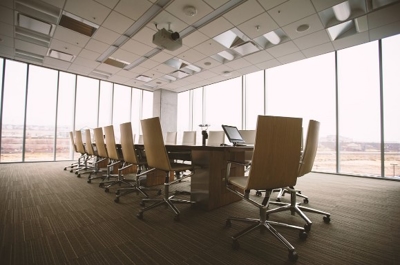Sick Building Syndrome: Is Your Office at Risk?
Table of Contents
- What is Sick Building Syndrome?
- Do I Have Sick Building Syndrome or Am I "Sick"?
- What Are the Symptoms of Sick Building Syndrome?
- What Causes Sick Building Syndrome?
- Sick Building Syndrome's Impact on Productivity
- 6 Ways to Help Prevent Sick Building Syndrome
- Don't Risk SBS: Contact ServiceMaster Clean for a Free Quote
What is Sick Building Syndrome?
Do you feel like your building makes you sick? This thinking is the essence of Sick building syndrome (SBS). Sick building syndrome is when folks experience health or discomfort issues tied to their time in a building.
According to the U.S. Environmental Protection Agency (EPA), sick building syndrome is “used to describe situations in which building occupants experience acute health and comfort effects that appear to be linked to time spent in a building, but no specific illness or cause can be identified.”
In other words, a building could be making you sick. You experience symptoms like headaches, fatigue, and nausea while in a building. But here's the key: If your symptoms improve when you leave the building, you probably have SBS, not a cold or flu.
Are you curious about what causes sick building syndrome and what symptoms to look for? Continue reading for helpful info from the professionals at ServiceMaster Clean.
Do I Have Sick Building Syndrome or Am I "Sick"?
It's easy to mistake Sick Building Syndrome (SBS) for a passing cold or flu.
But unlike a cold or flu virus, SBS symptoms tend to worsen while you're in a specific building and improve when you leave.
If you notice your symptoms ease shortly after leaving work and return when you're back, you likely have sick building syndrome.
What Are the Symptoms of Sick Building Syndrome?
Some sick building syndrome symptoms include the following:
- Headaches
- Dizziness
- Cough with or without chest pain
- Nausea
- Fatigue
- Muscle aches
- Fever
- Sore throat
- Eye irritation
- Skin rashes
- Nosebleeds, runny nose, or congestion
- Inability to concentrate
- Sensitivity to odors
The symptoms of sick building syndrome may appear as individual symptoms, in any combination of symptoms, or can even vary day by day. Sometimes, you may experience a specific symptom while a coworker suffers a different SBS symptom.
What Causes Sick Building Syndrome?
You can help prevent SBS in your facility by identifying some of the causes. According to the EPA, there have been many causes or contributing factors to sick building syndrome.
Some of the causes of SBS include:
- Inadequate ventilation
- Chemical contaminants from indoor or outdoor sources
- Biological contaminants, including mold and bacteria
Sick Building Syndrome's Impact on Productivity
Whatever mix of symptoms your employees feel, sick building syndrome can hurt their performance.
In fact, according to an article published in the National Center for Biotechnology Information (NCBI), SBS can reduce work efficiency and even increase absenteeism.
If you notice an increase in sick days recently, it may be time to consider the building as the culprit.
6 Ways to Help Prevent Sick Building Syndrome
To help reduce the risk of SBS from spreading throughout your workplace, follow these steps:
Improve Building Ventilation & Indoor Air Quality
Schedule an appointment with an HVAC contractor to ensure your HVAC system meets ventilation standards.
You also might need to have your exhaust ventilation checked and/or improved by an HVAC contractor. A commercial HVAC company can help improve your building's ventilation.
Improving office air quality by removing dust mites, mold spores, pollen, and other allergens is another way to help reduce sick building syndrome symptoms.
Maintain and Clean Your HVAC System
An HVAC company should maintain your HVAC system twice a year.
Check and Change Your Air Filters
You should ensure your air filters have an MERV rating of at least 13 or higher. The higher the MERV rating, the more air particles it'll capture.
You should also change your air filters every 3-6 months.
Moisture Control
Replace water-stained ceiling tiles to remove potential mold and mildew. Replace carpet that appears to have water damage. Finally, regularly clean all tile and tile grout to help eliminate mold growth.
Eliminate Pests
Remove all biological contaminants from your property, including insects and rodent droppings.
Professional Commercial Cleaning Services
Regular office cleanings can also help keep the facility fresh and welcoming for customers and employees.
Fighting Sick Building Syndrome requires more than a quick wipe-down. Professional janitorial services tackle the problem at its source.
You'll be better equipped to fight SBS, from routine vacuuming and dusting to disinfecting high-touch surfaces. It's a comprehensive approach to creating a healthier and more comfortable workspace.
Don't Risk SBS: Contact ServiceMaster Clean Today
A healthy facility is a clean facility. With a cleaner work environment, you may help boost employee morale, reduce sick days, and even increase productivity.
Are you concerned your facility may have issues that could contribute to sick building syndrome symptoms? If so, contact the professionals at ServiceMaster Clean.
As professional commercial cleaners, we understand the importance of healthy indoor environments. We address these issues through our cleaning and disinfection services.
We offer a variety of services to fit your schedule and unique needs. We deliver the highest standards of cleanliness every time we work, and we’re happy to help get your facility up to your expectations.
Contact your local ServiceMaster Clean to request your free quote!













